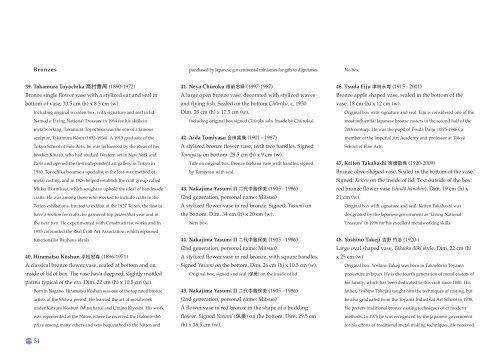Hotei Japanese Prints catalog autumn 2014
Samples of Japanese beauty Prints, paintings and design from three centuries.
Samples of Japanese beauty Prints, paintings and design from three centuries.
Create successful ePaper yourself
Turn your PDF publications into a flip-book with our unique Google optimized e-Paper software.
Bronzes<br />
purchased by <strong>Japanese</strong> governmental ministries for gifts to dignitaries.<br />
No box.<br />
39. Takamura Toyochika 高 村 豊 周 (1890-1972)<br />
Bronze single flower vase with a stylized ear and seal in<br />
bottom of vase, 33.5 cm (h) x 8.5 cm (w).<br />
Including original wooden box, with signature and seal in lid.<br />
Named a Living National Treasure in 1964 for his skills in<br />
metalworking, Takamura Toyochika was the son of a famous<br />
sculptor, Takamura Kôun (1852-1934). A 1915 graduate of the<br />
Tokyo School of Fine Arts, he was influenced by the ideas of his<br />
brother Kôtarô, who had studied Western art in New York and<br />
Paris and opened the first independent art gallery in Tokyo in<br />
1910. Toyochika became a specialist in the lost-wax method of<br />
metal casting, and in 1926 helped establish the craft group called<br />
Mukei (Formless), which sought to uphold the ideal of handmade<br />
crafts. He was among those who worked to include crafts in the<br />
Teiten exhibitions. Invited to exhibit at the 1927 Teiten, the first to<br />
have a section for crafts, he garnered top prizes that year and in<br />
the next two. He experimented with Constructivist works and in<br />
1935 cofounded the Real Craft Art Association, which espoused<br />
functionalist Bauhaus ideals.<br />
40. Hiramatsu Kôshun 平 松 宏 春 (1896-1971)<br />
A classical bronze flower vase, sealed at bottom and on<br />
inside of lid of box. The vase has a deep red, slightly mottled<br />
patina typical of the era. Dim. 22 cm (h) x 10.5 cm (w).<br />
Born in Nagano, Hiramatsu Kôshun was one of the top rated bronze<br />
artists of the Shôwa period. He learned the art of metalwork<br />
under Katsura Kôshun (Mitsuharu) and Umino Kiyoshi. His work<br />
was represented at the Nitten where he received the Hokutô-shô<br />
prize among many others and was bequeathed to the Nitten and<br />
41. Neya Chûroku 根 箭 忠 緑 (1897-1987)<br />
A large open bronze vase, decorated with stylized waves<br />
and flying fish. Sealed on the bottom Chûroku, c. 1930.<br />
Dim. 35 cm (h) x 17.5 cm (w).<br />
Including original box signed Chûroku saku (made by Chûroku).<br />
42. Aida Tomiyasu 会 田 富 康 (1901 - 1987)<br />
A stylized bronze flower vase, with two handles. Signed<br />
Tomiyasu on bottom. 29.5 cm (h) x 9 cm (w).<br />
Title on original box: Bronze ikebana vase with handles, signed<br />
by Tomiyasu with seal.<br />
43. Nakajima Yasumi II 二 代 中 島 保 美 (1905 - 1986)<br />
(2nd generation, personal name: Mitsuo)<br />
A stylized flower vase in red bronze. Signed: Yasumi on<br />
the bottom. Dim. 34 cm (h) x 20 cm (w).<br />
New box.<br />
44. Nakajima Yasumi II 二 代 中 島 保 美 (1905 - 1986)<br />
(2nd generation, personal name: Mitsuo)<br />
A stylized flower vase in red bronze, with square handles.<br />
Signed Yasumi on the bottom. Dim. 26 cm (h) x 10.5 cm (w).<br />
Original box, signed and seal ( 保 美 ) on the inside of lid.<br />
45. Nakajima Yasumi II 二 代 中 島 保 美 (1905 - 1986)<br />
(2nd generation, personal name: Mitsuo)<br />
A flower vase in red bronze in the shape of a budding<br />
flower. Signed Yasumi ( 保 美 ) on the bottom. Dim. 29.5 cm<br />
(h) x 16.5 cm (w).<br />
46. Tsuda Eiju 津 田 永 寿 (1915 - 2001)<br />
Bronze apple shaped vase, sealed in the bottom of the<br />
vase. 18 cm (h) x 12 cm (w).<br />
Original box with signature and seal. Eiju is considered one of the<br />
most influential <strong>Japanese</strong> bronze casters in the second half of the<br />
20th century. He was the pupil of Tsuda Daiju (1875-1946), a<br />
member of the Imperial Art Academy and professor at Tôkyô<br />
School of Fine Arts.<br />
47. Keiten Takahashi 高 橋 敬 典 (1920-2009)<br />
Bronze olive-shaped vase. Sealed in the bottom of the vase.<br />
Signed: Keiten on the inside of lid. Text outside of the box:<br />
red bronze flower vase (shudô hanabin). Dim. 19 cm (h) x<br />
21 cm (w).<br />
Original box with signature and seal. Keiten Takahashi was<br />
designated by the <strong>Japanese</strong> government as ‘Living National<br />
Treasure’ in 1996 for his excellent metalworking skills.<br />
48. Yoshino Takeji 吉 野 竹 治 (1920-)<br />
Large oval shaped vase, Takaoka dôki style. Dim. 22 cm (h)<br />
x 25 cm (w)<br />
Original box. Yoshino Takeji was born in Takaoka in Toyama<br />
prefecture in Japan. He is the fourth generation of metal casters of<br />
his family, which has been dedicated to this craft since 1800. His<br />
father, Yoshino Takejirô taught him the techniques of casting, but<br />
he also graduated from the Toyama Industrial Art School in 1938.<br />
He prefers traditional bronze casting techniques over modern<br />
methods. In 1975 he was recognized by the <strong>Japanese</strong> government<br />
for his efforts of traditional metal making techniques. He received<br />
54


